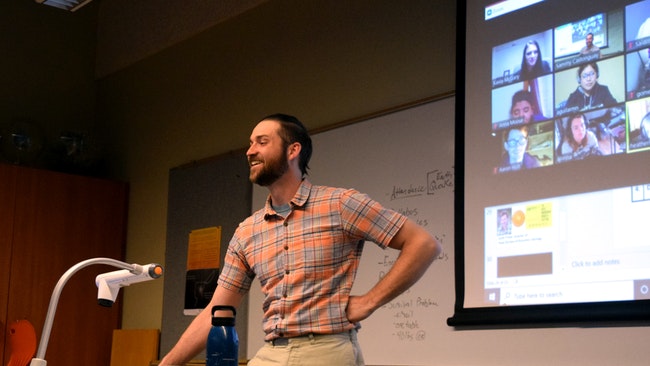
Sammy Castonguay, an earth sciences adjunct instructor at Treasure Valley Community College, conducting a general science course via Zoom at the beginning of spring term. (The Enterprise/Yadira Lopez)
ONTARIO – A recent evening class in Sammy Castonguay’s general science course kicked off with the usual – a little introduction, attendance and some small talk about the earthquake that had rattled the region.
Less usual was the way Castonguay, an adjunct instructor in earth sciences, conducted his class, speaking into a screen in his empty classroom and staring across a sea of mini-faces on his own computer.
Like nearly every other college across America, Treasure Valley Community College is turning to virtual learning in the face of the COVID-19 pandemic.
The college has spent weeks prepping for the move to virtual, said Abby Lee, TVCC’s public information director. She said the school moved 446 classes to “virtual,” not counting dual credit high school courses.
“We’re taking each program individually,” Lee said.
The college offered all faculty and students trainings in Zoom – the video-conferencing application of choice for many people now forced to work from home. Practice meetings ahead of the spring term that kicked off last week helped ensure everyone was prepared.
Nursing students received a waiver from the Board of Nursing that allows them to come on campus in small groups for hands-on activities they need to graduate.
The school was in good shape for some of the changes, Lee said.
The college already relies on an online portal that faculty and students use, and a federal grant from a few years ago gave the school access to an instructional designer who helps faculty get content online.
The college already offers several online classes each quarter; 72 online classes were scheduled this spring.
But virtual classes or “distance learning” has its challenges.
Some courses didn’t make the cut.
“How do you do welding online? You don’t, so we canceled welding,” Lee said.
For faculty and students, the virtual classes can feel both different and familiar.
“These are still in-person classes,” said Castonguay. “It’s still meeting at the same time, it’s just broadcast, and it’s still meant to be as if you’re a bunch of students sitting in your chairs and you can still raise your hands in Zoom as you would in a regular class.”
When spring classes began last week, Castonguay ran into some roadblocks.
Students seemed more hesitant to participate onscreen. There was less engagement since students have the option of turning off their camera – leaving him looking at a black box instead of a face.
Right away, he noticed distractions – ringing phones, dishes that needed washing, children clamoring for their parents.
“Some of our students have limited access to computers and limited technology experience, and they too are struggling to get used to the new delivery,” said Arwyn Larson, a biology professor at the college.
For students who lack WiFi and technology, the college opened two computer labs. Students can access the labs in small groups and computers are cleaned after each use and are set up to adhere to social distancing guidelines.
Larson said she’s spending an enormous amount of time creating content for this new format, but having taught two classes online for several years allowed her to transition more easily into distance learning.
To accommodate students, Larson is pre-recording lectures at home and holding office hours via Zoom to answer questions, have discussions and check in on students’ well being.
College is already hard enough, Castonguay said.He knows some of his students work long hours outside of class and hold down multiple jobs.
“Now on top of that, add that they are taking their home comfort environment and turning that into their workspace,” Castonguay said.
He can relate. Castonguay worked from home for the last two years, and it was a difficult transition, he said.
“It’s not that easy unless you have a place to treat as your office,” he said. That’s why with three young children at home, and a wife who is also working outside of the office, Castonguay is choosing to conduct his classes in his empty classroom on the college’s campus.
Castonguay and Larson said the sciences have an additional difficulty.
“To call these lab classes, students really need to get their hands on the material,” he said.
Lee said the college is hoping that as conditions improve, faculty will be allowed to hold some classes in person toward the end of the term.
Meanwhile Castonguay found other ways through the Zoom application to recreate his classroom. A feature on the application allows him to put students into virtual working groups.
He found that the key is to call on people by name – “let them know they are live people on the other end,” he said.
By the second class meeting, things were falling into place.
“I think everyone is working really hard to help students make this transition,” Larson said. “We care about them and we want them to be able to continue their educational journey toward their degree.”
Everyone has been resilient and resourceful, she added.
“I really miss having them in class/lab and being able to interact,” Larson said. But perhaps now I will appreciate it even more when we get to go back.”
Have a news tip? Reporter Yadira Lopez: [email protected] or 541-473-3377.
HELP THE COMMUNITY GET THE FACTS….
As long as we can, the Malheur Enterprise will provide free access to all stories related to COVID-19. With businesses closed and not advertising, community support for this service is vital. Help one of two ways:
SUBSCRIBE – $5 a month, automatically.
DONATE – to our LOCAL NEWS FUND. Tax deductible, and anonymous if you wish.
Thank you!



